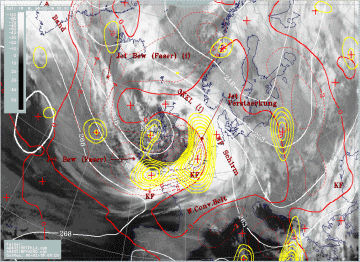18 - 19 February 1996 - Enhanced Cumulus
Within the cellular cold air cloudiness behind the cold front, there is an area over Northern Ireland reaching north-westwards where the tops of cells are colder. This is typical Enhanced Cumuli cloudiness (EC) (compare Conceptual Models: Enhanced Cumulus ). The characteristic key parameters and key parameter combinations are:
| Rel.Top. + TA=<0 | This combination gives an overview at the larger scale situation; typically ECs can be found within the thickness troughs on the rear of the Cold Front mostly within cold advection CA 500/1000 hPa |
|---|---|
| PVA500>=2 | Positive vorticity advection (PVA) at 500 hPa exceeding a threshold of 2 units (*10-9 sec-2); well developed cases show up with pronounced PVA maxima which can also be followed prognostically |
| Isot + PVA300>=3 | This is a combination of isotachs greater than 30 units (m sec-1) and positive vorticity advection (PVA) at 300 hPa exceeding 3 units (*10-9 sec-2); this combination indicates a special situation where ECs can develop, namely in the left exit region of jet streaks |
|
18 February 1996/06.00 UTC - Meteosat IR image; white: equivalent thickness 500/850 hPa, red thick: front indicator, red: temperature
advection - CA 1000 hPa, yellow: positive vorticity advection (PVA) 500 hPa, SatRep overlay: names of conceptual models
|
|
All key parameters show in this case a typical behaviour for the development of EC cloudiness. It is situated in the centre of a small-scale thickness trough (white isolines), in the maximum of cold advection (CA) (red dashed lines) and it coincides with a separate PVA maximum (yellow) at 500 hPa. A comparison with the jet streak situation (compare Intensification of cold front through jet streak crossing ) confirms that in addition to curvature, the EC is also under the influence of a left exit region of the Atlantic jet streak.
